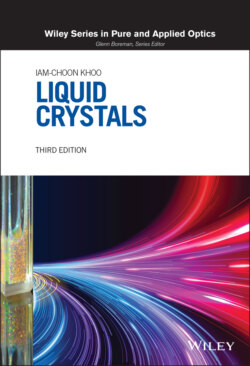Читать книгу Liquid Crystals - Iam-Choon Khoo - Страница 54
3.5.4. Flows with Director Axis Reorientation
ОглавлениеThe preceding section deals with the case where the director axis is fixed during fluid flow. In more general situations, director axis reorientation often accompanies fluid flows and vice versa. Taking into account the moment of inertia I and the torque , where is the molecular internal elastic field defined in Eq. (3.11), is the torque associated with an externally applied field, and is the viscous torque associated with the viscous forces, the equation of motion describing the angular acceleration dΩ/dt as the director axis may be written as
(3.65)
The viscous torque consists of two components [3]: one arising from pure rotational effect (i.e. no coupling to the fluid flow) given by and another arising from coupling to the fluid motion given by . Therefore, we have
(3.66)
Here is the rate of change of the director with respect to the immobile background fluid, given by
(3.67)
where is the angular velocity of the liquid. In Eq. (3.66) is the velocity gradient tensor defined by Eq. (3.60).
The viscosity coefficients γ1 and γ2 are related to the Leslie coefficient αs by [3]
(3.68a)
(3.68b)
Consider the flow configuration depicted in Figure 3.11. Without the magnetic field and setting ϕ = 0, we have
(3.69a)
(3.69b)
(3.69c)
(3.69d)
(3.69e)
From Eq. (3.66) the viscous torque along the y‐direction is given by
(3.70)
In the steady state, from which the shear torque vanishes, a stable director axis orientation is induced by the flow with an angle θflow given by
(3.71)
For more complicated flow geometries, the director axis orientation will assume correspondingly complex profiles.
